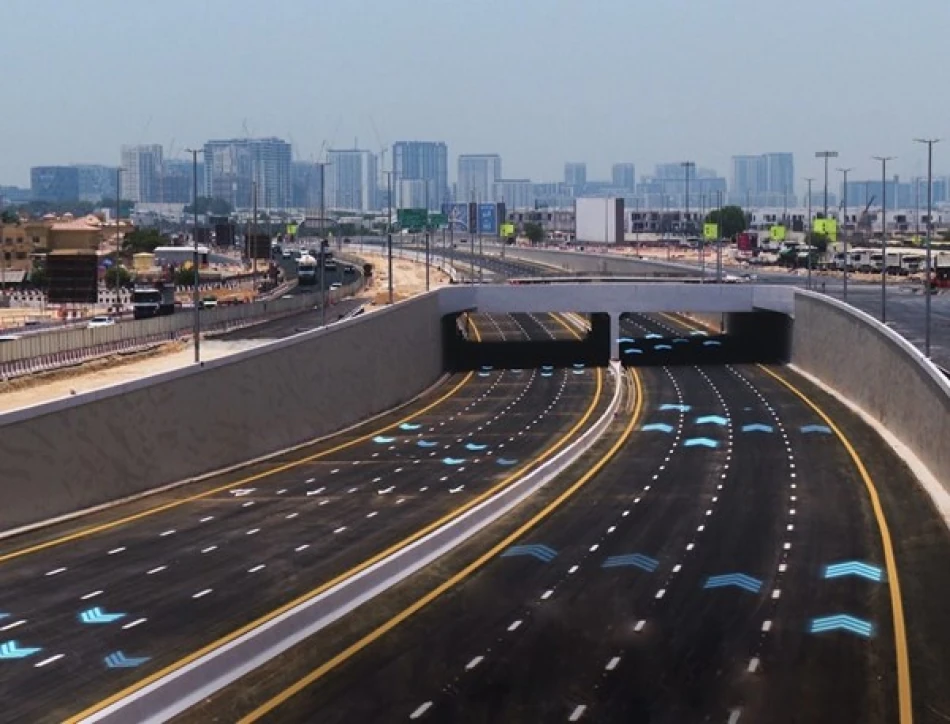
Dubai's Roads Authority Unveils Massive Time-Saving Tunnel on Um Suqeim Street, Slashing Commute by 61%
Dubai Opens Major 800-Meter Tunnel as Part of $1 Billion Infrastructure Push
Dubai's Roads and Transport Authority has unveiled an ambitious 800-meter tunnel featuring four lanes in each direction along Um Suqeim Street, marking another milestone in the emirate's relentless infrastructure expansion. The project serves over one million residents across key residential and commercial districts, cutting travel times by 61% while boosting road capacity to 16,000 vehicles per hour—a clear signal that Dubai remains committed to maintaining its edge as a regional business hub despite global economic uncertainties.
Strategic Connectivity at the Heart of Dubai's Growth Model
The newly opened tunnel represents more than just another road project—it's a calculated investment in Dubai's economic future. Located along the Um Suqeim-Al Qudra corridor, the infrastructure connects four of Dubai's most strategic arteries: Sheikh Zayed Road, Al Khail Road, Sheikh Mohammed bin Zayed Road, and Emirates Road.
This 4.6-kilometer stretch serves critical areas including Al Barsha South phases 1-3, Dubai Hills, Arjan, and Dubai Science Park. For international businesses evaluating regional headquarters locations, such connectivity improvements directly translate to operational efficiency and reduced logistics costs.
Travel Time Revolution
The tunnel's impact on productivity cannot be overstated. Journey times between Sheikh Mohammed bin Zayed Road and Al Khail Road have plummeted from 9.7 minutes to just 3.8 minutes—a 61% reduction that compounds across millions of daily trips. In a city where time literally equals money, this efficiency gain represents millions in saved productivity costs annually.
Technology-Driven Project Management Sets New Standards
Dubai's approach to infrastructure development increasingly mirrors its broader smart city ambitions. The Um Suqeim project showcased cutting-edge project management techniques that other global cities are likely to adopt.
The RTA deployed drone technology powered by artificial intelligence to monitor construction progress, achieving 100% field presence coverage while reducing survey time by 60%. Time-lapse photography provided 24/7 construction monitoring, improving oversight efficiency by 40%.
These innovations matter beyond Dubai. As infrastructure costs soar globally—with projects routinely exceeding budgets by 20-50%—Dubai's tech-enabled approach offers a replicable model for cities from Singapore to smart city developments across Saudi Arabia's NEOM project.
Phased Development Strategy Minimizes Disruption
Dubai's methodical approach to the Um Suqeim corridor demonstrates sophisticated urban planning. The project unfolds across multiple phases spanning over a decade, allowing the city to spread costs while minimizing traffic disruption.
Phase one, completed in 2013, delivered two bridges with three lanes each direction between Sheikh Zayed Road and Al Khail Road, plus three pedestrian bridges. The 2020 phase added a 500-meter bridge serving Dubai Hills Mall with 16,000 vehicles per hour capacity. The current tunnel completion represents phase three of this master plan.
Investment Climate Implications
This phased approach signals fiscal discipline that international investors monitor closely. Unlike cities that launch massive infrastructure programs only to face budget crises, Dubai's measured execution suggests sustainable growth planning. For real estate investors and multinational corporations, this predictable infrastructure development reduces long-term operational risks.
Regional Competition and Global Context
Dubai's infrastructure investments occur against intensifying regional competition. Saudi Arabia's $500 billion NEOM project and Qatar's World Cup infrastructure legacy create pressure on Dubai to maintain its regional hub status.
The numbers tell the story: Dubai's 16-kilometer Um Suqeim-Al Qudra corridor represents one piece of a broader east-west connectivity strategy designed to complement existing north-south routes. This grid approach mirrors successful urban planning in cities like Singapore and Barcelona, where comprehensive connectivity drives economic competitiveness.
For businesses choosing between Dubai, Riyadh, or Doha as regional headquarters, infrastructure quality often proves decisive. Dubai's consistent delivery record—completing projects on schedule with advanced technology integration—maintains its competitive advantage even as neighbors increase their infrastructure spending.
Economic Multiplier Effects
The tunnel's economic impact extends far beyond transportation efficiency. Improved connectivity typically drives property values in served areas by 10-15%, while reduced commute times attract higher-skilled workers willing to live further from business districts.
For the million-plus residents in areas like Dubai Hills and Al Barsha South, the infrastructure upgrade enhances quality of life while potentially boosting property values. International property investors monitoring Dubai's market should note that such infrastructure improvements historically correlate with sustained price appreciation in connected neighborhoods.
Dubai's latest tunnel opening reinforces the emirate's commitment to infrastructure-led growth, setting benchmarks for project management technology while maintaining its regional competitive edge through strategic connectivity investments.
 Layla Al Mansoori
Layla Al Mansoori







